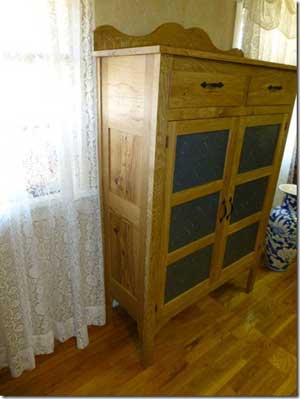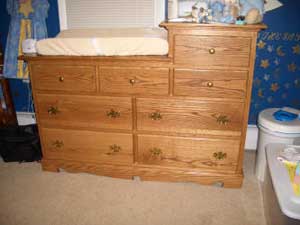
Granddaughter Project: One More Suggestion
In last issue’s Feedback, we shared the responses from readers to Rob’s query about what he should build his granddaughter for her first Christmas. This suggestion highlights a project from our own annals. – Editor

“Teddy Bear Kids Rocking Chair. This was in your magazine a few years back. I’ve made several of them, and all the kids have loved them. I changed the plan a little by making the back an inch taller and doubled the seat thickness to carve it out for making it more comfortable for sitting. I’ve always made them out of oak, but my next one I’m thinking of making out of black walnut and maple to have it be more like a Panda Bear.” – Jim Gustafson
First Five Tools
We also asked you, last time out, which five tools you thought a newbie woodworker should first stock in the shop. Here’s one vote. – Editor
“Regarding 5 best tools reader response: For me it would be, in order: 1) Compound Sliding Miter Saw, 2) Router with Table, 3) Drill or Drill Press, 4) Table Saw, 5) Planer.” – Ron Grow
What’s the Bevel For?
And here’s a reader response about what he, at least, uses the beveled end of a sliding T-bevel for (the source of wonder for one of our questioners in last issue’s Questions & Answers section). – Editor
“I can’t that this is precisely what the beveled end on the blade of a sliding T bevel is ‘for,’ but I have used it to mark the cut line for a chamfer. The Dictionary of Woodworking Tools shows a sliding bevel with a square end that is named a ‘Canada Pattern Sliding Bevel.’ The Dictionaryalso notes that some of the earlier bevels had an ogee profile on the blade, so the angled end may be a simplification of this.” – J.W. Dougherty
Still More Tales of Trees to Lumber
What’s that they say about making lemon out of lemonades? In the wake of Hurricane Sandy’s visit to the U.S. East Coast, we’re continuing the saga of woodworkers who responded to Rob’s query a while back about who had made lumber (and/or projects) from trees they’d personally known. This time out, we’ve compiled quite a few responses from woodworkers who experienced earlier hurricanes, and other storms. – Editor
“My trees to lumber story is not so much because I wanted to build something from my own timber, but due to the ‘encouragement’ of my wife. When Hurricane Katrina roared through our family farm in Mississippi, we lost all our pine timber as well as our hundred-year-old pecan grove, which had been planted by my grandmother. Most of the pine went to the pulpwood mills for pennies on the dollar, but my wife could not bear to see those old pecan trees bulldozed into piles and burned. (There was no market for hardwood in our neck of the woods.) At my wife’s urging, we went to the AgExpo in Moultrie, Georgia that fall and purchased a portable band saw mill. The next year or so was spent milling the fallen pecan, as time permitted. As I was employed full-time and lived 200 miles from our farm, it was difficult to make progress in this labor-intensive chore. Friends and family helped us off and on as we could get together, and I finally ended up with a barn full of stickered pecan lumber, along with a little bit of cedar. The first project that I made with this wood was small footstools for my brother, son and daughter, as mementos of the family pecan grove. The next items made with this lumber were several narrow bedside tables for various family members. Some received a natural finish, while others were painted with a crackle finish. I have not yet decided what my next use of this wood will be, but whatever it is, it will have special meaning to our family.” – Stanley Thigpen
“In 2011, Hurricane Irene wreaked havoc along the Atlantic coast of the U.S. Irene pushed over an 80-plus-year-old hickory in my front yard. On the way down, it hit a 80-plus-year-old shortleaf/yellow pine and the crown of the hickory missed my house by inches, defoliated an American beech and buried two of my neighbors’ vehicles. The stem of the hickory was nearly 50′ in length, and I logged the bottom 30′ in 3 roughly 9-10″ lengths. After several weekends of effort, I had only the stump (on its side) and 3 massive logs in my yard. Then we took down the pine for fear that it could have been damaged by the blow the hickory gave it. Now I had 6 logs roughly 9-10 feet in length in my front yard. I then enlisted the help of a local lumber mill, Ferguson Custom Sawmill LLC, who showed up with a trailer, a new winch, and we loaded the logs with 3 of my other neighbors. My front yard is a big concave bowl and we had to roll the logs out to get them up the trailer ramps. The 6 logs yielded about 600 board feet. I had the hickory quartersawn into 3.5” beams of various widths to make a massive country gate styled headboard and bed frame. The pine I had cut into 6/4 planks varying in width from 6-8” wide. It is slated to become my shed floor next spring. I have outdoor burned some of the hickory’s smaller limbs and the rest of the stem and larger limbs will be split this fall for firewood and BBQ smoking fuel. While pickup, delivery, and milling cost me $800, I must admit a significant amount of satisfaction in making use of the resources that Mother Mature deposited in my yard. Lastly, in the days after the storm, many a contractor stopped and offered cleanup services. The cheapest quote I got to completely remove the tree and stump from the yard was $1,500, and that did not include leaving me any firewood!” – Gregg Genworth
“Several years ago, a tornado came through an adjacent city. I saw an ad in the newspaper where somebody had had his fallen oak trees cut into lumber and was selling the wood at a reasonable price. Obviously, it was quite wet, and was not all prime grade. But there was lots of nice wood in the 100bf I bought. It did sit in my basement for a year before I tried to use it to ensure it was reasonably dry. I made some very nice (I think) tables and assorted smaller projects from it. Much better than just burning the wood.” – Jeff Engel
“I have taken a few ‘last year’s ice storm damage’ limbs and turned them quite successfully. (For me), the trick is to cut it thin, and keep it wet. If you want to try a thin wall lathe project, I would recommend doing it green. If you have to leave the project overnight before it is finished, seal it with the chips you cut from the item, inside and out to keep it from drying too fast to allow it to settle in and not split.” – Riley G.
Unfortunately, other natural disasters have also led to the end of trees’ lives. – Editor
“Being from the thumb of Michigan, there are hundreds of ash trees dying everywhere from the emerald ash bore beetle, and on my dad’s farm, there’s about 10 acres of woods, of which a large part is ash. In the past 5 years, we’ve harvested over 5000 bf of ash, and we’ve used it for just about everything. We had a local guy come in with a portable band saw and cut it up for us to whatever dimensional lumber we wanted, from 1 inch boards for cabinets to 10×10 barn beams. Then we stored it in the back corner of one of our sheds for approximately a year before using it. My dad used some of it for repair work to his 100-year-old cattle barn. I had some of the ash cut into 2X4’s and built a 24 X 24 addition on my garage. The ash wood has also come in handy for several kitchen cabinets, dressers, etc. that were also made out of 100 percent solid ash wood. As you probably already know, ash has a real nice grain and color to it. I actually prefer it, myself, over red oak, which used to be my wood of choice for many of my projects.” – Paul Learman
Of course, sometimes it’s not the trees that are the most memorable part of a “trees to lumber” experience, but the ability to realize a loved one’s dream, or make a connection. – Editor
“I have always been one to go from trees to lumber for my projects, It started when my dad bought the woods when I was in high school and we harvested some of the trees for future projects, and continued when I got married and my father-in-law and I harvested some trees that were polluting the sugar bush and some of the older distressed sugar bush trees. It is a lot more work than just buying the lumber, but there is a personal connection with the wood and the project. Hardest part is planning long enough ahead so the wood is dry when you are ready to make the project, or you can just cut what is available and have plenty for whatever project comes up.” – Brian Brummel
“This is a pie safe I built from two trees on my neighbor’s yard that fell. I just delivered it to my mother in Yoder, Wyoming. The trees are white oak from Oakland, Oregon. The wood air dried for five years. Just the two-day trip from 58 percent humidity to 25 percent humidity made the wood move more than I thought would happen.” – Greg Willard
“When we bought our house, the original owners had lived in it for nearly 30 years. Early on, they had planted four silver maples, and by the time we acquired the property, these trees were reaching the end of their lifespan. Two are still alive and doing well, but a few years ago we had to take the other two of them down. The trunk sections were fairly straight, so I saved them and had them milled into 4/4 and 8/4 lumber by a fellow with a portable sawmill. The two trees yielded about 80 bf of nice soft maple with some decent figure to boot. The total cost ended up being about $0.80/bf, well worth the effort. I have used the wood for several projects like picture frames and such. I even used it as secondary wood for a set of end tables that I built. For Christmas this year, I plan to make a keepsake box using some of the more figured wood and send it to the original owners of the house as a gift. I think they might enjoy having a little piece of their old homestead.” – Scott Keith
And some woodworkers pursue this type of project mainly for their own pleasure. – Editor
“Seven years ago, my wife and I settled on a blueprint for our dream home. When I started calculating the amount of woodwork in the home, I realized this was my opportunity to build the shop, acquire the tools, and do the woodworking I had always dreamed of doing. I purchased a TimberKing B-20 Bandmill, bought a Nyle L200 kiln, and started our ‘dream home’ by building a 3,200 square foot woodworking shop. Over the next two years, I sawed some 200,000 board feet of white oak, walnut, red oak and cypress, kiln-dried it, milled it into crown molding, facing, baseboard, stairs, something over 70 interior doors, 5 exterior doors, and lots and lots of kitchen cabinets and bathroom vanities. (I was fortunate to hire three experienced woodworkers who stayed with me from start to finish — I wasn’t nearly experienced enough to tackle the job without them.)
“Although I doubt if I want to go through that again, I wouldn’t take anything for the experience, knowledge, and satisfaction that project gave me. There’s nothing quite as satisfying as seeing beautiful flecked quartersawn white oak emerge from the planer and knowing that the final product will be enjoyed and appreciated for decades to come. That feeling is surpassed only when you wipe on a good finish and really see the beauty of the wood pop out before you. Now my shop is a place I go to tinker and occasionally build something for my kids or grandkids. If you have a hankering for woodworking from the stump up, and if you have the wherewithal and ability to get, operate, saw, dry, and mill your own logs, by all means, go for it.” – Charles McCullough
“I cut my own trees, only in the winter after the sap has gone down, have the Amish saw it, air dry it in a pole barn with a wood floor for 5 years, stuck. I do most of my woodworking in the winter, so I bring what I think I’ll need for a project in the basement where I have a wood burner. I finish drying it for approximately 2 weeks; normally it will test 6 to 8 percent moisture. I’ve had good luck doing this. I build dressers and such. One thing I have found out is that air dried red oak is not as aromatic as red oak that has been kiln dried.” – Lloyd Funk
And we’ll conclude the tales of trees to lumber with this long short story of an experience from someone whose tree was a bit larger than usual. – Editor
“I had always wanted to do this, but never had a situation where it made sense. Well, for the last few years a neighbor and I have been discussing taking down a tree on our shared property line. It was too close to her house, and slowly causing damage to it. I kept looking at the tree – at least 60′ tall. It was one of the straightest trees I have seen, for one that tall. I imagined I could get some amazingly long boards out of it. In the last year, we decided to put some solar panels on our house, and that was another incentive to take the tree down. So I called around, and finally found someone willing to take the tree down. It was going to require a large crane as it was within 5′ of my neighbor’s house. I also found someone with a portable mill that was willing to drive to my house (in the city) and mill the trunk. He said his machine could handle up to 2 tons. I asked about what size to make the logs, as I thought I would want long boards. (Then again, I didn’t have a clear use for the wood, just that I figured I’d make some furniture with it.) He suggested to cut the logs down to 8′ or 9′ long. I asked how long it would take for him to mill — he said one day. This was based on my rough estimate of the size.
“I had no idea how much I would get out of it. I searched the net for calculators to determine how much wood I could get out of it. The calculators were not super precise, but I figured I was going to get a LOT. I also needed to find a place to store it while it dried. Originally, I thought I could store it on the roof garage. I have a concrete garage with a flat roof.
“Well, the guys came to take the tree down. They cut the limbs up into small logs for splitting and burning. I gave most of that to a guy that works with me, as he has a woodburning stove in his house. They cut the large trunk into approximately 9′-10′ lengths. These things were massive. The diameter of the largest log was over 3′. Jim (the guy with the portable mill) showed up the next day. He looked a little incredulous when he saw the trunks. (Side note: as a rule of thumb, a tree isn’t worth milling unless it is at least 12” in diameter, according to Jim). He was like, ‘People tell me they have big trees, and I always say – ‘Yeah I can do it in a day,’ as they generally overestimate the tree size. You are not one of those people. I have never done a tree this big before.’ We were a bit worried about getting the first trunk onto the machine. It took almost half the day to get the first trunk onto the machine. I guess it was over two tons. It was also too big for his machine to easily spin for cutting. So it was a bear to work. The blade kept binding, or would have trouble getting the machine around the log, so using a chainsaw, we would trim little bumps off the outside of the log so his machine could slide back and forth.
“Based on Jim’s recommendations, the wood was not going on the roof of my garage (way too heavy). I had set up some cribbing to put the boards on in a corner of my yard. I did this based on some info I found on the net. When we finally got going, I explained that I wanted the log quartersawn where possible. Jim suggested a thickness of just over 1″, so that when it was later finished, I would have 1” thick boards. Again, as I had not clear plans for the wood — aside from making some furniture, I took his advice.
“Eventually, we got the log down to a size that his machine could manage. It took the better half of the day. Once the machine is set in a rhythm, Jim just sets the interval, and the blade just keeps dropping the same amount. That way each board is the approximately the same thickness. This make for easier stacking. Jim would cut, and Chris and I would carry the board over to a corner of my yard. We tried to separate the wood into two stacks – plainsawn and quartersawn. Based on the way the machine works, we needed to plain saw the first few boards until we got a relatively square log. Then we could quarter saw it.
“After we finished the first and biggest log, the smaller logs were within the manageable size for his machine. So they went a lot quicker. All in all, it took two days. I stacked it on a bed of 4×4 posts I had. These, in turn, were put onto concrete blocks. Unfortunately, one of the concrete blocks cracked — so I had to take the stack down and restack it with better (i.e., more) supports. I put some plywood over the top, and stapled some roofing paper on the top. The roofing paper needed to be held down with some strapping, as the staples would just pull out. We also used some ratcheting straps around the bundles to compress the boards and help keep them straight. Another suggestion from Jim.
“The boards have been in my yard for about 8 months, I just borrowed a moisture meter from colleague, and they appear to be 12-14 percent. Jim suggested that when I am ready to use the wood, to work slowly with it.; i.e., take the piece into my shop, plane the sides. Let it sit for a day, then plane the sides again, let it sit, etc. Give the wood time to adjust to its surroundings.
“I ended up with approximately 1,500 board feet of red oak. I have more than a few pieces over 30” wide and over 8′ long. Probably more wood than I could ever use. I started to ask around for a way to possibly sell some of it — to help defray the milling costs. My local woodworking shop at first was like, ‘red oak…not really interested.’ Then I showed him some pictures, and he was like, ‘YES, let me know when it is ready!’
“So far so good – then again, I haven’t tried to use any of it yet. I hope to start in on it this winter.” – Kevin Guarnotta







